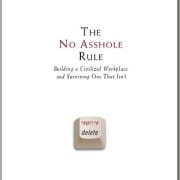Bob Sutton’s No Asshole Rule
I’ve been preparing a post about the challenging people we encounter in a legal practice: the nasty opposing counsel, the client who always reminds you of the cliche that with “friends” like this, who needs enemies; and even the rare colleague at work who’s a terrific attorney/paralegal/secretary/whatever but radiates fury or blame or negativity. We all have bad days, but my thoughts were centered on how to cope when we encounter and have to deal with someone who is truly a jerk. As I sometimes do, I typed in a few keywords to see what other people say about this kind of situation, and a fascinating blog popped up, all built around Bob Sutton’s “No Asshole” rule. The post I originally contemplated will be forthcoming on another day, because this rule deserves its own post.
Now, I will apologize upfront for using that phrase — it’s the author’s phrase, and the distaste that the phrase brings with it actually mirrors the distaste that we all feel when we work with one of those people. But the author uses it, on the grounds that when he sees “a mean-spirited person damaging others, no other term seems quite right.” Truth told, of course, most lawyers hear and probably use coarser words on a daily basis.
Anyway.
The blog I found is Bob Sutton’s Work Matters. (Love the photo.) And in the top right hand corner, you’ll see an Amazon link to Sutton’s forthcoming (February 2007) book, The No Asshole Rule: Building a Civilized Workplace and Surviving One That Isn’t. The blog also links to a tamer-titled Sutton column on Nasty People, as well as a video of Sutton discussing the genesis of the rule, which he first wrote about in the Harvard Business Review. (I confess that I normally hate website audio and video because it’s so much quicker to read than to watch/listen, but this 4:42 video is very well worth watching.) Sutton, a Stanford professor, says we can identify workplace assholes through their addiction to rude interruptions and subtle put-downs, and their use of sarcasm and “teasing” as “insult delivery systems.”
In describing a talk on the No Asshole Rule that he recently gave, Sutton identified three interesting thoughts that emerged from what sounds like a fascinating conversation between himself and his audience:
1. There’s a big difference between intentional assholes and unintentional assholes:
The consensus seemed to be that more forgiveness, patience, and understanding is in order when people travel through life in a clueless state, and need help learning how they make other’s feel. The consensus also was, in contrast, that certified assholes who demean others on purpose, and who do it because they believe it enables them get ahead at other’s expense, or to simply feel superior to others, deserve little if any sympathy — and that such bullies ought to be punished and banished. This sounds right to me.
2. Workplace asshole identification is a tricky, inherently flawed concept:
Drawing the firm dividing line between an “asshole” and a “non-asshole” isn’t easy, but I know one when I see one. And although I do offer a definition of workplace assholes, I also realize that the world is messy and that it will overlap with lots of other concepts.
3. Assholes tend to inflict their demeaning behavior on those who have less power than themselves. However, peer-on-peer abuse (prevalent in organizations where many share a medium amount of power, such as a partnership) and “asshole underlings” are not unknown.
The relevance of the No Asshole Rule may be lost on some, but just about every practicing lawyer I’ve ever encountered has a story that illustrates the difficulty of working for or with an asshole. Don’t believe me? Ask around.
The lesson from the No Asshole Rule is twofold. First, of course, don’t be an asshole. We all have an inner jerk who escapes on occasion, but if it starts getting out too much, or if someone lets you know your anger is out of hand, control yourself. And if you find yourself working for or with an asshole, know that you aren’t alone, call the situation what it is, and do your part in whatever way possible to bring this rule to your organization’s attention. Unfortunately, abusive lawyers may be permitted to stay on in law firms when they bring in sufficient income, so enforcement is sometimes unlikely. The tide may be turning, however, as illustrated by Sutton’s story about Perkins Coie, recited in the Nasty People column:
The Seattle law firm Perkins Coie is more specific. They have a “no jerks allowed” rule, which helped earn them a spot on Fortune magazine’s “100 Best Companies to Work For” in 2003, and again in 2004. According to a Seattle Times article, Perkins Coie partners Bob Giles and Mike Reynvaan were once tempted to hire a rainmaker from another firm but realized that doing so would violate “the rule.” As they put it, “We looked at each other and said, ‘What a jerk.’ Only we didn’t use that word.”
I’ll be curious to read Sutton’s book when it’s published. This is one rule I’d love to see gain predominance in the legal profession — and in society in general.




Leave a Reply
Want to join the discussion?Feel free to contribute!